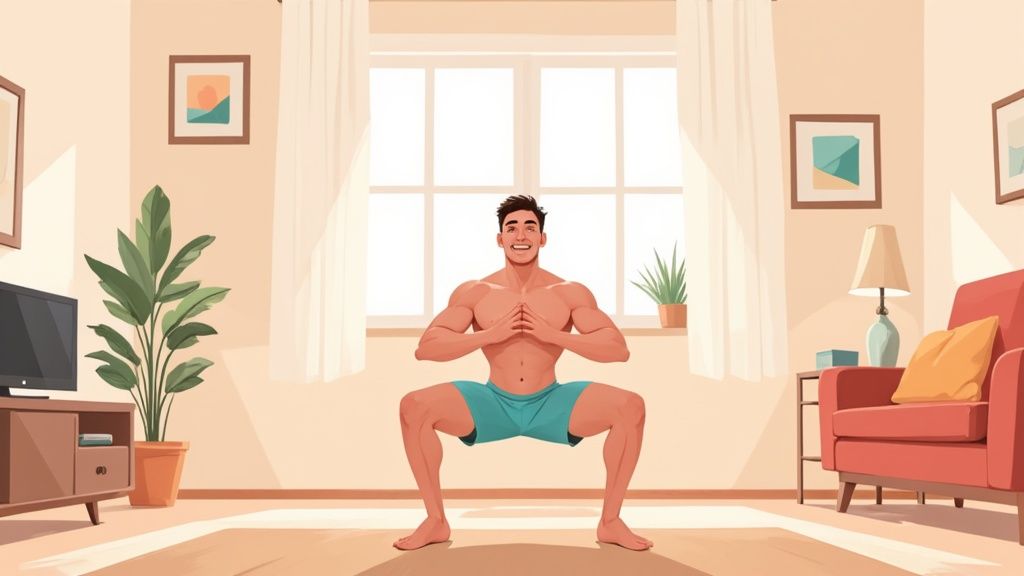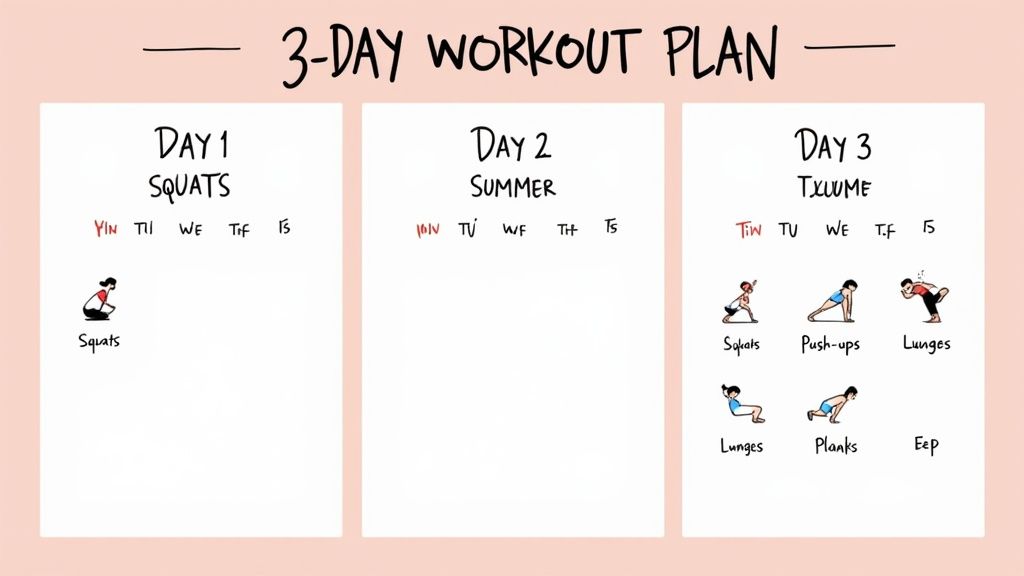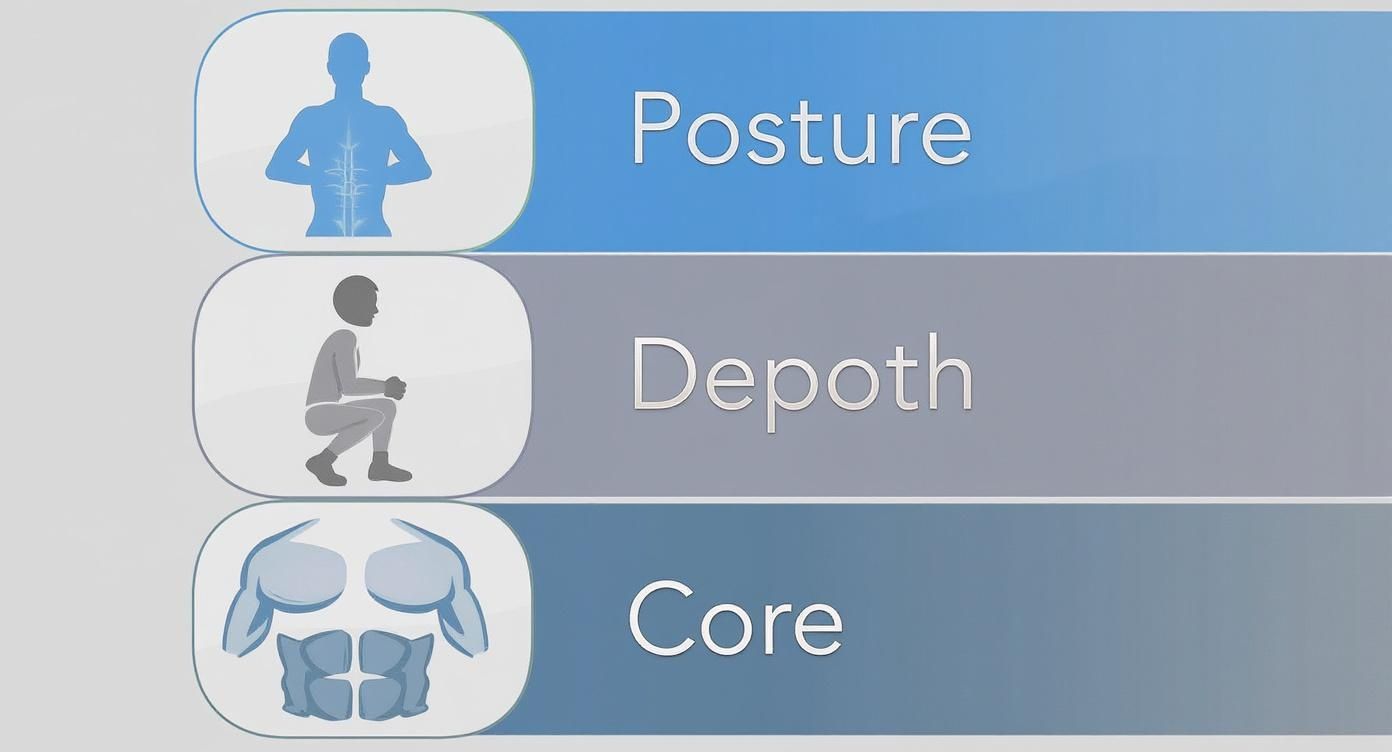Welcome to strength training! If you're new to this, the best place to start is right where you are, using just your body. It’s the simplest, most accessible way to build a solid foundation of strength without ever stepping foot in a gym. At Bare Fitness, we believe effective strength training for beginners doesn't require a pile of expensive equipment.
This guide will show you exactly how to start. We'll cover what you really need (it's less than you think), a simple 3-day workout plan with step-by-step instructions, and how to keep making progress from your living room.
Your Permission Slip To Get Strong

Does the term "strength training" make you think of loud, intimidating gyms filled with complicated machines? You’re not alone. For too long, getting strong has felt like something reserved for an exclusive club. At Bare Fitness, we're here to change that.
Our mission is to prove that the most powerful piece of fitness equipment you'll ever own is your own body. This guide is your no-nonsense, jargon-free introduction to building real, functional strength—completely on your terms.
What Strength Really Means (It's Not About the Gym)
Let's clear something up: this isn't about lifting the heaviest weight in the room. Real strength is about moving through your daily life with more confidence and less effort. It's the power to carry all your groceries in one trip or play with your kids without feeling wiped out. It’s the quiet confidence that comes from knowing what your body is capable of.
This is what strength training for beginners should be about. It’s not about how you look; it’s about feeling capable and empowered in your own skin.
What to Expect From This Guide
I've designed this guide to cut through the noise and give you a clear, actionable path. We're sticking to the essentials to get you started with confidence.
Here’s our game plan:
- Simplicity is Key: We’re skipping the complex jargon and focusing on practical movements that actually work.
- A Minimalist Mindset: You don't need a fancy home gym. We'll show you exactly how to use your bodyweight to build surprising strength.
- Confidence First: This plan is built for small wins. It’s designed to be achievable, so you can build momentum from your very first workout.
The payoff goes way beyond building muscle. You're investing in your long-term health. The science is clear: just 30 to 60 minutes of muscle-strengthening activity each week can slash your risk of premature death from chronic diseases by 10-20%. That's a huge return on a small time investment. You can read more about these significant health benefits for yourself.
This isn't just another workout plan. It's a fresh start. Consider this your official permission slip to begin right where you are, use what you have, and discover your own strength.
This journey is all about progress, not perfection. I'll walk you through the fundamental movements, help you build a routine that sticks, and teach you how to celebrate the wins along the way. Your path to a stronger, more confident life starts right now. Let’s get to it.
What You'll Need to Get Started

Let's cut through the noise. The fitness industry loves to convince you that you need a room full of expensive gear to get started, but that’s just not true. Honestly, the most powerful and effective tool for strength training for beginners is the one you already have: your own body.
This minimalist approach isn't a compromise; it’s a smart strategy that lets you build a rock-solid foundation without cluttering your space or your budget.
The Bare Essentials: Your Toolkit
We’re keeping this list incredibly simple because your focus should be on doing the work, not on buying stuff.
- Your Body: This is your number one piece of equipment. Bodyweight exercises are fantastic for building strength, improving stability, and mastering proper form without the risk of adding too much weight too soon.
- A Designated Space: You don't need a home gym. Just find a small patch of floor—an area the size of a yoga mat is perfect—where you can move freely without knocking over a lamp.
- Comfortable Clothing: Wear something that lets you move without restriction. A t-shirt and shorts or leggings are perfect.
- A Positive Mindset: This is the most important tool. Your mindset is the engine of your progress. Cultivating consistency and patience is more crucial than any piece of equipment you could ever buy.
Optional (But Nice to Have):
- A Yoga Mat: A simple mat can make floor exercises like planks or glute bridges more comfortable, but it’s definitely not a requirement.
Before you do your first push-up, take a minute to think about what you really want to achieve. Is it having more energy? Feeling more confident? Getting through the day with fewer aches? Write it down. Putting your "why" on paper turns a vague wish into a concrete mission.
Your Foundational Workout Plan
Alright, this is where we put theory into practice. You’ve got your space ready and your mind right—now it’s time to get moving. I’ve put together a straightforward and effective 3-day, full-body workout plan designed for anyone just getting into strength training for beginners.
This isn't just a random list of exercises. It's a structured starting point designed to build your confidence right alongside your strength, helping you get stronger without getting hurt.

Structuring Your Week for Success
Consistency is key. To see real progress, you have to give your muscles time to rest and rebuild. For beginners, a full-body routine done three times a week on non-consecutive days is the gold standard. This schedule gives your muscles about 48 hours to recover between sessions, which is when they repair and grow stronger.
Here's a sample schedule to give you an idea:
Your 3-Day Beginner Full-Body Workout Schedule
Life happens, so don't feel locked into this exact schedule. The most important thing is getting those three workouts in with at least one day of rest in between.
Step 1: The All-Important Warm-Up
Never skip your warm-up. Think of it as sending a memo to your body that it's time to work. A good warm-up gets blood flowing to your muscles, lubricates your joints, and reduces your risk of injury.
Your 5-Minute Dynamic Warm-Up:
- Marching in Place: 60 seconds. Get those knees up to start elevating your heart rate.
- Arm Circles: 30 seconds forward, then 30 seconds backward. Make them big and controlled.
- Torso Twists: 60 seconds. With feet shoulder-width apart, gently rotate your upper body.
- Leg Swings: 30 seconds per leg. Hold a wall for balance and swing one leg forward-and-back, then side-to-side.
Step 2: Your Full-Body Workout Circuit
We'll use a circuit format. This just means you'll do one set of each exercise one after the other with minimal rest in between. After you’ve done every exercise once, that’s one complete circuit.
Rest for 60-90 seconds after each circuit. Aim for a total of three rounds.
- Bodyweight Squats: 10-15 reps
- Incline Push-Ups (using a chair or wall): 8-12 reps
- Alternating Lunges: 8-10 reps per leg
- Plank: Hold for 20-30 seconds
- Glute Bridges: 12-15 reps
Your Goal: Forget about speed. Focus entirely on good form. I'd much rather see you do 8 perfect push-ups than 12 sloppy ones. Quality movement builds a strong, resilient body.
The world of strength training for beginners has exploded. Fitness app downloads are projected to fly past 5 billion worldwide, and many offer beginner-friendly guidance. This massive shift toward accessible fitness makes it easier than ever to get started. You can learn more about these evolving fitness trends and see how technology can support you.
Step 3: Don't Forget the Cool-Down
Just as a warm-up gets you ready, a cool-down helps your body shift back into rest mode. It gradually brings your heart rate down and can make a big difference in flexibility and how sore you feel tomorrow.
Take five minutes after your last circuit for these static stretches. Hold each one for 20-30 seconds—no bouncing!
Your 5-Minute Cool-Down:
- Quad Stretch: Stand, holding a wall for support. Grab your right foot and gently bring your heel toward your glute. Repeat on the other side.
- Hamstring Stretch: Sit on the floor with one leg straight and the other bent. Hinge at your hips and gently lean forward over the straight leg. Switch sides.
- Chest Stretch: Stand in a doorway. Place your forearms on the frame with your elbows just below shoulder height and step forward until you feel a nice stretch across your chest.
This foundational plan is your starting line. Next, we’ll dive into each exercise with detailed instructions to make sure you’re nailing the form from day one.
Getting Your Form Right on the Essentials
Good form is everything. It’s the difference between building real strength and just going through the motions—or worse, getting injured. Your goal is to master the movement itself before you ever think about adding weight.
Let's break down the exercises from your workout plan with clear, step-by-step instructions and form cues.
You’re not alone in focusing on this. A 2025 report found that gyms are dedicating up to 40% more floor space to strength training, meeting the demand from people just like you. The game has changed; it's all about quality movement, which you can perfect at home. You can read the full report on fitness trends to see just how big this movement is.
1. The Bodyweight Squat
You squat every time you get in and out of a chair. Mastering it builds serious strength in your quads, hamstrings, and glutes.
Step-by-Step Instructions:
- Start with your feet just a bit wider than your hips, toes pointing slightly out.
- Keep your chest up and look straight ahead.
- Push your hips back first, as if you're about to sit in a chair.
- Lower yourself until your thighs are about parallel to the floor, or as deep as you can comfortably go.
- Drive back up by pushing through your entire foot, squeezing your glutes at the top.
Common Mistake to Avoid: Don't let your knees collapse inward. Actively think about pushing them out so they track in line with your feet.
2. The Incline Push-Up
The push-up is a full-body classic. The secret to strength training for beginners is starting with a version you can master.
Step-by-Step Instructions:
- Find a sturdy, elevated surface like a kitchen counter or a strong desk. The higher the incline, the easier it will be.
- Place your hands on the surface, just wider than your shoulders.
- Walk your feet back until your body forms a straight line from head to heels. Brace your core to prevent your hips from sagging.
- Lower your chest toward the surface, keeping your elbows tucked at a 45-degree angle.
- Press firmly back to the start, maintaining control.
Progression: As you get stronger, move to a lower surface (like a coffee table or stairs) to increase the challenge.
3. The Alternating Lunge
Lunges are phenomenal for building single-leg strength and improving your balance.
Step-by-Step Instructions:
- Stand tall with your feet together and hands on your hips.
- Take a large, controlled step forward with your right foot.
- Lower your hips straight down until both knees are bent at a 90-degree angle. Your front knee should be over your ankle, and your back knee should hover just above the floor.
- Keep your torso upright.
- Push off your front foot to return to the starting position.
- Repeat with the left leg. That's one rep for each side.
Common Mistake to Avoid: Don't let your front knee drift past your toes. Think about dropping your hips down, not moving forward.
4. The Plank
The plank strengthens your entire core—abs, obliques, and lower back—which provides stability for nearly every other exercise.
Step-by-Step Instructions:
- Get on the floor on your forearms and knees, with your elbows directly under your shoulders.
- Lift your knees off the floor and extend your legs straight back.
- Your body should form a straight, solid line from your head to your heels.
- Brace your abs, squeeze your glutes, and keep your hips in line with your shoulders.
- Hold the position and remember to breathe.
Common Mistake to Avoid: Don't let your hips sag. If you feel it in your lower back, your hips have dropped. Squeeze your glutes to lift them back into alignment.
5. The Glute Bridge
This simple move is a powerhouse for activating your glutes and hamstrings and protecting your lower back. It's an essential part of any strength training for beginners program.
Step-by-Step Instructions:
- Lie on your back with your knees bent and feet flat on the floor, hip-width apart.
- Place your arms by your sides, palms down.
- Drive through your heels and squeeze your glutes to lift your hips toward the ceiling, creating a straight line from your shoulders to your knees.
- Pause for a second at the top, squeezing your glutes hard.
- Slowly and with control, lower your hips back down.
Common Mistake to Avoid: Don't arch your lower back to get your hips higher. The movement should come from your hips, driven entirely by your glutes.
How to Keep Making Progress
Doing the same workout week after week is great for building a habit, but it won’t keep you getting stronger. Your body is smart—it adapts. To keep seeing results, you have to gently nudge it out of its comfort zone.
This is called progressive overload. It simply means making your workouts a little bit harder over time. And you don't need a single dumbbell to do it, especially when you're just starting with strength training for beginners.
Simple Ways to Increase the Challenge (Without Weights)
Here are a few powerful techniques you can start using:
- Add More Reps: This is the most straightforward method. If you did 10 squats last week, aim for 12 this week.
- Slow Down the Movement: This increases "time under tension." Try taking three full seconds to lower into a push-up and another three to press back up. It makes every rep count for more.
- Reduce Your Rest Time: If you normally rest for 90 seconds between circuits, trim that to 75 seconds. This builds endurance and keeps your heart rate up.
- Try a Harder Variation: Once you can comfortably do 15 incline push-ups against your kitchen counter, find a lower surface, like a sturdy coffee table.
Before you start making things harder, make sure your form is perfect. This infographic is a great visual reminder of what a perfect squat looks like.

Nailing these details—keeping your chest up, hitting proper depth, and engaging your core—is the foundation. Don't rush past it.
Tracking Progress Beyond the Scale
The number on the scale is not the best measure of your success. When you start strength training for beginners, you might build muscle while losing fat, so your weight might not change much at all.
That's why focusing on "non-scale victories" is so important. These are the real-world signs that you’re getting stronger.
Celebrate every small win. Being able to do one more push-up or noticing your energy levels are higher is real, tangible progress. Acknowledge it and be proud.
Start paying attention to these wins, because they’re what will keep you motivated:
- Performance Gains: Did you hold your plank for five seconds longer? Keep a simple workout journal to track your reps and sets. Seeing those numbers climb is incredibly rewarding.
- Increased Energy: Are you hitting that 3 PM slump as hard? That's your body becoming more efficient.
- Better Mood: Regular exercise is a powerful mood booster.
- Clothes Fit Differently: Your weight might be the same, but your body composition is changing. If your clothes feel a little looser, that’s a fantastic sign you're on the right track.
Next Steps and Related Workouts
Once you feel confident with this routine and have been consistent for 4-6 weeks, you're ready for the next step! Here are some ideas:
- Add a fourth workout day to your week.
- Introduce new bodyweight exercises like Reverse Lunges, Pike Push-Ups, or Supermans.
- Explore minimal equipment options, like a single resistance band, to add a new challenge.
Your Top Strength Training Questions, Answered
Starting something new always sparks a few questions. That's a good thing! Let's tackle the most common ones so you can move forward with total confidence.
How often should I train as a beginner?
A great starting point is two to three full-body strength sessions per week on non-consecutive days. This gives your muscles the signal they need to grow and enough downtime to recover and repair.
Remember: consistency will always beat intensity. A schedule you can stick to for months is far more powerful than one that leaves you burned out in two weeks.
Is it normal to be this sore?
Yes! Feeling sore a day or two after a new workout is totally normal. It’s called Delayed Onset Muscle Soreness (DOMS). It's a dull ache in the muscles you trained, and it's a sign that your body is adapting. It shouldn't be a sharp pain, especially in your joints.
To ease soreness, drink plenty of water, do some light activity like walking, and prioritize sleep.
Can I actually lose weight just by strength training?
Absolutely. While many people think weight loss is all about cardio, strength training is a powerhouse for changing your body composition. Muscle burns more calories at rest than fat does, so building muscle effectively boosts your metabolism.
When you combine strength training with a sensible eating plan, you create a powerful combination for sustainable fat loss, helping you build a strong, lean physique.
Ready to build a strong foundation without the clutter and confusion? Bare Fitness is your home for simple, effective workouts you can do anywhere. Discover your strength with us today.




















